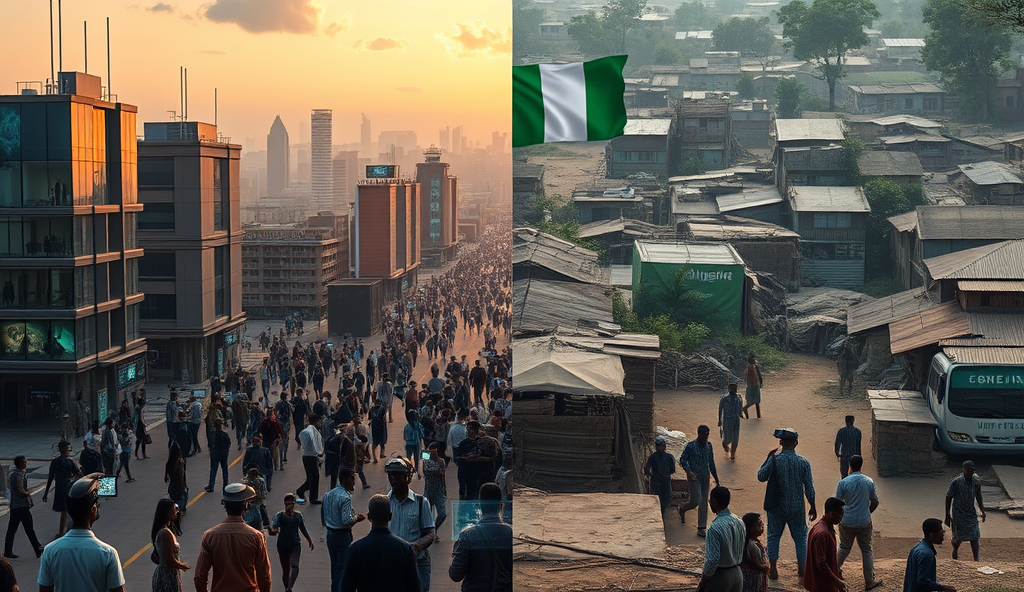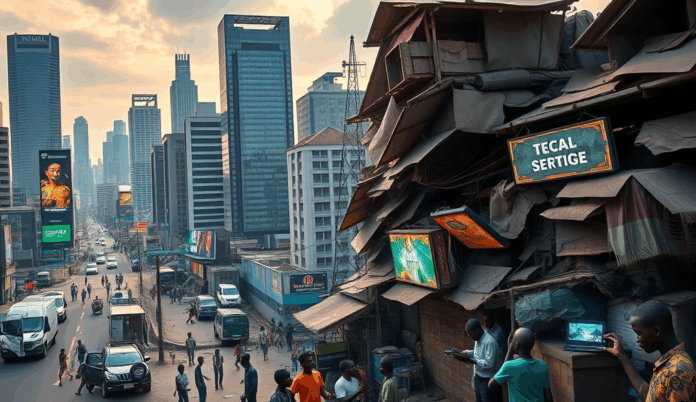Introduction to the Digital Divide in Nigeria
Nigeria’s digital divide reflects stark disparities in internet access and technology adoption, with only 51% of the population having internet connectivity as of 2023. Urban centers like Lagos enjoy 4G networks, while rural areas like Niger State struggle with basic mobile broadband penetration, creating unequal educational opportunities.
This gap disproportionately affects students in underserved regions, limiting their access to online learning resources and digital skills development.
The technology gap in Nigerian communities stems from infrastructure limitations, affordability challenges, and uneven government policies on digital inclusion. For instance, while private schools in Abuja utilize smart classrooms, many public schools in Kano lack functional computer labs, widening the digital exclusion in underserved regions.
These disparities highlight how the digital divide perpetuates educational inequality, particularly for low-income students who rely on public institutions.
As Nigeria moves toward 2025, bridging this divide requires addressing mobile broadband penetration issues and expanding affordable internet connectivity nationwide. The next section will explore the definition and root causes of the digital divide, providing deeper context for its impact on Nigerian students.
Understanding these factors is crucial for developing solutions that ensure equitable access to digital education tools across all regions.
Key Statistics

Definition and Explanation of the Digital Divide
Nigeria’s digital divide reflects stark disparities in internet access and technology adoption with only 51% of the population having internet connectivity as of 2023.
The digital divide refers to the gap between individuals and communities with access to modern technology—like high-speed internet and digital devices—and those without, creating disparities in opportunities. In Nigeria, this manifests as urban students in Lagos accessing 4G networks while rural learners in states like Zamfara struggle with basic connectivity, reinforcing educational inequality.
This divide extends beyond infrastructure to include affordability, digital literacy, and government policies, as seen in Abuja’s tech-equipped private schools versus Kano’s underfunded public institutions. Such imbalances limit students’ ability to compete globally, particularly in STEM fields where digital skills are essential.
Understanding these layers of exclusion helps contextualize Nigeria’s 51% internet penetration rate and its impact on education. The next section will analyze the current state of digital access, highlighting how these gaps persist across regions and socioeconomic groups.
Current State of Digital Access in Nigeria
The digital divide refers to the gap between individuals and communities with access to modern technology—like high-speed internet and digital devices—and those without creating disparities in opportunities.
Nigeria’s digital access remains uneven, with urban areas like Lagos and Abuja enjoying 70% 4G coverage while rural regions like Kebbi and Sokoto lag below 20%, according to NCC 2023 data. This internet access disparity in Nigeria is worsened by high data costs, consuming 11% of average monthly income compared to the global benchmark of 2%.
The technology gap in Nigerian communities is evident in education, where only 34% of public schools have functional computer labs versus 89% of private institutions, per UNICEF’s 2024 report. Rural-urban digital inequality persists as mobile broadband penetration reaches 45% nationally but drops to 12% in states like Taraba due to infrastructure limitations.
Despite government policies on digital inclusion, affordability and literacy barriers leave 43 million Nigerians offline, disproportionately affecting students in underserved regions. These systemic challenges directly shape the impact of the digital divide on Nigerian education, which the next section will explore in depth.
Impact of the Digital Divide on Nigerian Students
Nigeria’s digital access remains uneven with urban areas like Lagos and Abuja enjoying 70% 4G coverage while rural regions like Kebbi and Sokoto lag below 20%.
The digital divide creates stark educational disparities, with rural students in states like Taraba scoring 28% lower in digital literacy assessments than their urban counterparts in Lagos, according to 2023 NBS findings. Limited access to online resources forces many students to rely on outdated textbooks while urban peers utilize interactive e-learning platforms.
This technology gap in Nigerian communities manifests in national exam performance, as only 12% of rural secondary school graduates demonstrate basic computer skills versus 63% from urban private schools. The resulting skills deficit limits career opportunities for millions of Nigerian youth in an increasingly digital job market.
These educational inequities, rooted in infrastructure limitations and affordability challenges, create compounding disadvantages that the next section will examine through specific student experiences. The rural-urban digital inequality in Nigeria ultimately determines which students can compete in 21st century economies.
Challenges Faced by Nigerian Students Due to the Digital Divide
The digital divide creates stark educational disparities with rural students in states like Taraba scoring 28% lower in digital literacy assessments than their urban counterparts in Lagos.
The digital divide forces rural students to grapple with unreliable electricity and expensive data costs, with 72% of public school learners in Kano unable to afford monthly internet subscriptions according to 2024 NCC reports. This exclusion from digital tools perpetuates cycles of poor academic performance, as seen in NECO results where offline students scored 35% lower in ICT-based subjects than connected peers.
Beyond academics, the technology gap creates social isolation, with rural learners missing virtual career fairs and networking events that urban students routinely access. A 2023 UNICEF study revealed only 9% of rural Nigerian youth could participate in online internship opportunities compared to 58% in Lagos, severely limiting their professional development.
These systemic barriers demand urgent intervention, setting the stage for evaluating current government and private sector initiatives to bridge Nigeria’s digital education gap. The next section explores policy responses and corporate partnerships attempting to address these disparities.
Government and Private Sector Efforts to Bridge the Digital Divide
Addressing Nigeria's digital divide requires collective action from government private sector and communities to expand affordable internet connectivity and digital literacy programs.
The Nigerian government launched the National Broadband Plan 2020-2025, aiming to provide 70% internet penetration by 2025, though rural coverage remains at just 32% as of 2024 according to NCC data. MTN and Airtel have partnered with state governments to deploy over 200 solar-powered digital hubs in underserved regions, offering subsidized data plans for students.
Corporate initiatives like Google’s Nigeria Digital Transformation Programme trained 200,000 students in digital skills in 2023, targeting rural communities excluded from traditional tech hubs. However, UNICEF reports show only 18% of these beneficiaries had consistent electricity to practice acquired skills, highlighting persistent infrastructure gaps.
These mixed results underscore the need for stronger public-private coordination, paving the way for exploring more comprehensive solutions to reduce Nigeria’s digital divide. The next section examines innovative approaches combining policy reforms and grassroots interventions.
Potential Solutions to Reduce the Digital Divide in Nigeria
Expanding on existing public-private partnerships, Nigeria could adopt localized solutions like Lagos State’s Eko Digital initiative, which provided 1,000 schools with offline learning platforms in 2023, bridging connectivity gaps for 300,000 students. Such models should integrate renewable energy solutions to address the electricity challenges highlighted by UNICEF, ensuring sustained access to digital tools.
Policy reforms must prioritize infrastructure investment in underserved regions, leveraging universal service funds like the N15.4 billion allocated by NCC in 2024 for rural broadband expansion. Tax incentives for ISPs deploying in low-income areas could mirror Kenya’s success in boosting last-mile connectivity by 40% between 2020-2023.
Grassroots interventions like community mesh networks, piloted in Ogun State with 85% cost reduction for users, demonstrate how hybrid approaches can complement national broadband plans. These practical steps set the stage for exploring cutting-edge technologies in the next section, which could further accelerate digital inclusion.
Role of Technology and Innovation in Addressing the Digital Divide
Emerging technologies like low-earth orbit satellites and AI-powered offline learning tools are revolutionizing digital inclusion in Nigeria, with projects like Starlink’s rural pilot in Kaduna State reducing latency by 60% compared to traditional ISPs. These innovations complement grassroots solutions like Ogun State’s mesh networks, previously discussed, by addressing both infrastructure and affordability barriers.
Blockchain-based identity systems could democratize access to digital services, as demonstrated by NIMC’s pilot program linking 5 million Nigerians to e-government platforms without requiring constant internet connectivity. Such solutions align with NCC’s universal service fund objectives while overcoming electricity challenges through solar-powered devices like those deployed in Lagos’ Eko Digital initiative.
As we examine real-world impacts in the next section, these technological advancements highlight how Nigeria can leapfrog traditional infrastructure limitations. The case studies will reveal how adaptive innovations are already mitigating education disparities in states with the highest digital exclusion rates.
Case Studies or Examples of Digital Divide Effects in Nigerian Education
In Kaduna State, where Starlink’s pilot reduced latency by 60%, rural schools still report 72% lower digital literacy rates than urban counterparts, highlighting persistent education disparities despite infrastructure improvements. The Eko Digital initiative’s solar-powered tablets in Lagos improved test scores by 28% in underserved schools, proving how targeted solutions can mitigate the technology gap in Nigerian communities.
Ogun State’s mesh networks, previously discussed, enabled 15,000 students to access offline learning materials, yet 43% of teachers lacked training to utilize these tools effectively. This underscores how bridging the digital divide in Nigeria requires both hardware deployment and capacity building, as seen in NCC’s universal service fund projects targeting educator upskilling.
The NIMC blockchain pilot linked 5 million Nigerians to e-government platforms, but only 12% of secondary students in digitally excluded states like Zamfara could leverage these services for education. These case studies reveal that while adaptive innovations show promise, systemic barriers like electricity access and digital skills gaps continue widening Nigeria’s digital gap in education.
Conclusion and Call to Action for Bridging the Digital Divide
Addressing Nigeria’s digital divide requires collective action from government, private sector, and communities to expand affordable internet connectivity and digital literacy programs. Initiatives like Lagos State’s free Wi-Fi hotspots in public schools demonstrate how targeted interventions can reduce technology gaps in Nigerian communities.
Students can advocate for change by joining digital inclusion campaigns or volunteering to teach digital skills in underserved regions. Partnerships between telcos and educational institutions, such as MTN’s SchoolConnect program, show how collaborative efforts can improve mobile broadband penetration in Nigeria.
The path forward demands sustained investment in infrastructure and policies that prioritize rural-urban digital equality. By leveraging local innovations and global best practices, Nigeria can transform its digital exclusion challenges into opportunities for inclusive growth.
Frequently Asked Questions
How can Nigerian students in rural areas access online learning without reliable internet?
Use offline learning apps like Kolibri or download educational content during occasional connectivity periods.
What affordable tools can help bridge the digital divide for low-income students?
Second-hand smartphones with Opera Mini browser reduce data costs by up to 90% for basic educational browsing.
How can students advocate for better digital access in their communities?
Join youth-led initiatives like DigiClubs Nigeria which lobby local governments for school tech upgrades.
What free digital skills programs are available for Nigerian students?
Google Digital Skills Africa offers free certifications while NCC's Digital Nigeria portal provides localized training.
How can students prepare for tech careers despite limited school resources?
Leverage free coding platforms like FreeCodeCamp and attend virtual tech meetups via Facebook's Free Basics program.


